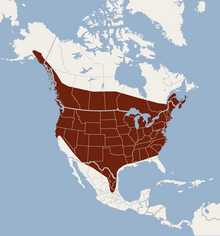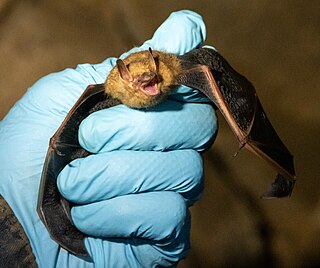
The tricolored bat or American perimyotis is a species of microbat native to eastern North America. Formerly known as the eastern pipistrelle, based on the incorrect belief that it was closely related to European Pipistrellus species, the closest known relative of the tricolored bat is now recognized as the canyon bat. Its common name "tricolored bat" derives from the coloration of the hairs on its back, which have three distinct color bands. It is the smallest bat species in the eastern and midwestern US, with individuals weighing only 4.6–7.9 g (0.16–0.28 oz). This species mates in the fall before hibernation, though due to sperm storage, females do not become pregnant until the spring. Young are born helpless, though rapidly develop, flying and foraging for themselves by four weeks old. It has a relatively long lifespan, and can live nearly fifteen years.

The big brown bat is a species of vesper bat distributed widely throughout North America, the Caribbean, and the northern portion of South America. It was first described as a species in 1796. Compared to other microbats, the big brown bat is relatively large, weighing 15–26 g (0.53–0.92 oz) and possessing a wingspan of 32.5–35 cm (12.8–13.8 in).
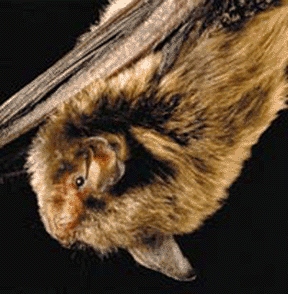
The Indiana bat is a medium-sized mouse-eared bat native to North America. It lives primarily in Southern and Midwestern U.S. states and is listed as an endangered species. The Indiana bat is grey, black, or chestnut in color and is 1.2–2.0 in long and weighs 4.5–9.5 g (0.16–0.34 oz). It is similar in appearance to the more common little brown bat, but is distinguished by its feet size, toe hair length, pink lips, and a keel on the calcar.

The hoary bat is a species of bat in the vesper bat family, Vespertilionidae. It lives throughout most of North America.

The southern yellow bat is a species of vesper bat that belongs to suborder microchiroptera (microbat) in the family Vespertilionidae. It is native to South, North and Central America, from the Rio Grande Valley of Texas in the United States to Argentina.

The eastern red bat is a species of microbat in the family Vespertilionidae. Eastern red bats are widespread across eastern North America, with additional records in Bermuda.
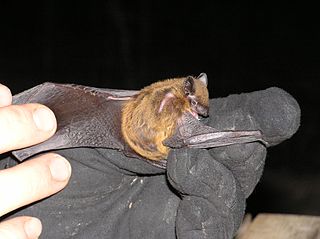
The evening bat is a species of bat in the vesper bat family that is native to North America. Hunting at night, they eat beetles, moths, and other flying insects.

The common noctule is a species of insectivorous bat common throughout Europe, Asia, and North Africa.

The Hawaiian hoary bat, also known as ʻōpeʻapeʻa, is a species of bat endemic to the islands of Hawaiʻi. The Hawaiian hoary bat occupies the major Hawaiian islands, making it the only extant and native terrestrial mammal in the islands. Some studies report that the mainland hoary bat lives in sympatry on the Hawaiian Islands alongside the Hawaiian hoary bat, although this is disputed. The Hawaiian hoary bat was officially named the state land mammal of Hawaiʻi in 2015. It is a federally listed endangered taxon of the United States.

Townsend's big-eared bat is a species of vesper bat.

The long-legged myotis is a species of vesper bat that can be found in western Canada, Mexico, and the western United States.
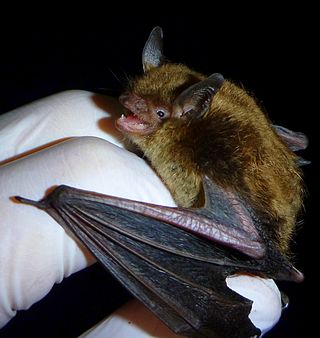
The little brown bat or little brown myotis is an endangered species of mouse-eared microbat found in North America. It has a small body size and glossy brown fur. It is similar in appearance to several other mouse-eared bats, including the Indiana bat, northern long-eared bat, and Arizona myotis, to which it is closely related. Despite its name, the little brown bat is not closely related to the big brown bat, which belongs to a different genus.

There are at least 50 small mammal species known to occur in Yellowstone National Park.

Myotis septentrionalis, known as the northern long-eared bat or northern myotis, is a species of bat native to North America. There are no recognized subspecies. The northern long-eared bat is about 3–3.7 inches in length, with a wingspan of 9–10 inches. It is distinguishable by its long ears when comparing it to other bats in its genus. This species is commonly found in the northern United States and Southern Canada east of British Columbia. The geographic range includes 37 states.
There are eighteen indigenous species of bats in Canada, which are found in many parts of the country. They are insectivores, and are prey to falcons, hawks, owls, snakes, cats, and raccoons.

